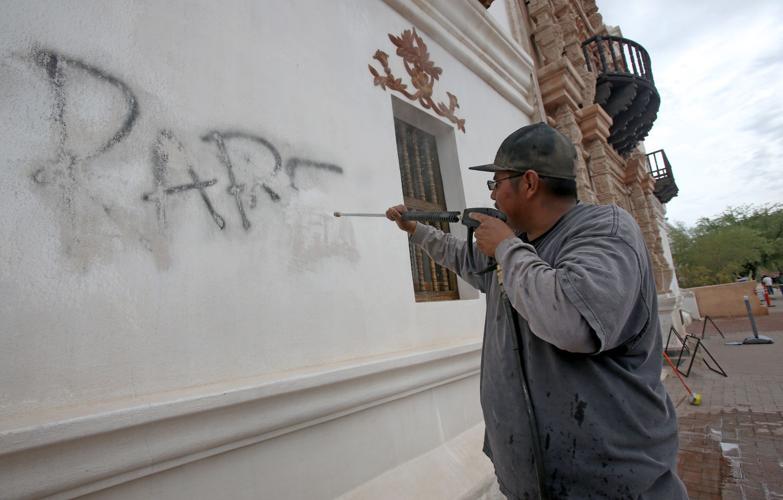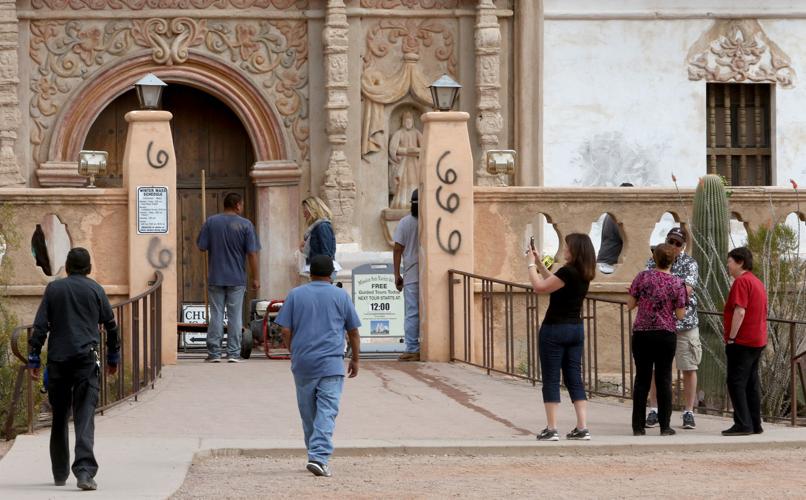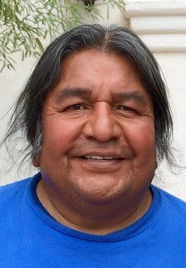As news crews arrived at the Mission San Xavier del Bac on Thursday morning, seeking details on the black graffiti marring the historic church’s exterior, Christine Encinas watched from a few hundred yards away, wiping tears from her cheeks.
She hadn’t seen the graffiti, and she didn’t want to.
“I don’t know what kind of people would do that, destroying something so special,” said Encinas, who is Tohono O’odham. She grew up in San Xavier and works at a souvenir shop near the mission. “I’ve never seen anything done to it.”
The vandalism, discovered early Thursday morning, is under investigation by the Tohono O’odham Police Department. The mission church is located south of Tucson in the San Xavier District of the Tohono O’odham Nation.
Although the interior of the church was unaffected, vandals damaged the mission’s white, lime-mortar exterior, the courtyard walls, a sidewalk and a nearby tribal cemetery.
By Thursday afternoon work crews had already removed most of the markings on the walls, which will have to be resurfaced.
All the damage can be repaired and won’t seriously affect the ongoing restoration of the church, officials said.
During Thursday’s 8:30 a.m. Mass, the Rev. Edward Sarrazin said he “prayed for the person who did this, that their heart would be softened.”
“The church has withstood earthquakes and lightning strikes,” he said. “We’ll get over this.”
Mission San Xavier is now heightening security around the church, he said.
Daniel Morales, whose family has worked on the mission restoration for four generations, said the vandalism hurt everyone.
“At Mass this morning, you could see the sadness in the people’s eyes. Everybody was stunned.”
Morales said the graffiti is painful because the mission belongs to everyone. While he was saddened this morning, his spirits were lifted by the response.
“This guy showed up with his power washer and said, ‘Where can I start?’ ” Morales said.
Mission San Xavier supporters felt a sense of urgency to get the church cleaned before today’s memorial service for renowned historian and author Bernard “Bunny” Fontana, the leading expert on San Xavier.
Fontana, whose career in Southwestern history and archaeology stretched six decades, died April 2 at age 85.
The church is deeply personal for the Tohono O’odham people, whose ancestors built the mission, said Tim Lewis, an art conservator. He was one of four Tohono O’odham apprentices who, in the 1990s, were trained by an international team of art restoration specialists to help preserve the church’s interior.
“It’s a part of our heritage,” he said. “Our ancestors built it. We’re trying to maintain their memory.”
Of those who committed the vandalism, Lewis said, “It’s just sad they had to resort to this to get recognition.”
“There’s just no words,” said Carolyn Reino, who is Tohono O’odham and owns C.R. Arts and Crafts, a shop at the San Xavier Plaza near the mission. “How disrespectful to a place that is holy.”
James Griffith, the retired anthropologist and folklorist, was at the San Xavier Cooperative, just south of the mission, to talk to a group of mission docents when he was told about the graffiti.
“What can I say? It’s a damn shame,” said Griffith, shaking his head.
REPAIRS UNDERWAY
Since 1978, nonprofit Patronato San Xavier has overseen the preservation of and fundraising for the mission.
“It was an extensive case of sacrilege against an iconic, historic structure,” said Chuck Albanese, president of the Patronato San Xavier board of directors. “It’s a sacrilege against the mission that represents all the values of this community, well beyond the church.”
To resurface the exterior walls that were vandalized, workers will use a mixture of lime, sand, water and cactus juice, as a bonding agent, Albanese said. The material allows the walls to breathe and release moisture, mirroring the original techniques used to construct the brilliant white walls of the church, also known as the White Dove of the Desert.
Built between 1783 and 1797, the Mission San Xavier del Bac is a National Historic Landmark known for its Spanish Colonial architecture in a Baroque style. The mission, Arizona’s oldest intact European structure, is still an active parish and draws roughly 200,000 visitors each year from around the world.
In November the mission was named to the 2016 World Monuments Watch — a list of cultural heritage sites that are fragile and in need of international attention to ensure their future.
For Arlene Antone O’Brien, who grew up in a small village on the Tohono O’odham Nation, the desecration of the mission felt very personal.
“It felt like somebody died,” said O’Brien, who now lives in Tucson. She came to the mission Thursday morning to hear a friend sing, which she said helped revive her spirits.
“I felt stronger and better after that,” she said.
On Thursday, a man with a long, dark ponytail and tattoos on his arms walked up to the faint black lines on the Mission walls where workers had power-washed away the graffiti.
Without words, he kissed his finger and touched the wall, then made a sign of the cross over the damage. Then he walked to the next image and repeated his act of respect and faith.











